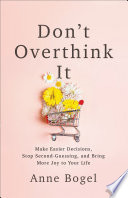

In a world filled with information overload and complex choices, the author emphasizes the power of simplicity. Overthinking often leads to paralysis by analysis, where individuals become stuck in decision-making processes. The book suggests that simplifying decisions, whether in personal life or work, can lead to more effective outcomes. By focusing on essential elements and reducing unnecessary complexity, individuals can enhance their productivity and satisfaction. The author provides strategies for identifying what truly matters and encourages readers to let go of non-essential tasks and thoughts, thus fostering a more straightforward approach to life.
Continue readingThe book introduces practical decision-making frameworks that help readers navigate choices with confidence. By establishing criteria for making decisions, individuals can avoid the trap of overthinking. The author presents various models, such as the 80/20 rule, which suggests that 80% of results come from 20% of efforts. This framework encourages readers to prioritize their focus on high-impact activities. Additionally, the book discusses the importance of setting deadlines for decisions to combat procrastination and promote action. These frameworks serve as tools to streamline thought processes and make informed choices without falling into the overthinking trap.
Continue readingOne of the key messages of 'Don't Overthink It' is the acceptance of imperfection. The author argues that striving for perfection can lead to excessive rumination and dissatisfaction. By embracing the idea that mistakes are part of the learning process, individuals can free themselves from the fear of failure. The book encourages readers to take action despite uncertainties and to view setbacks as opportunities for growth. This mindset shift not only alleviates the pressure to make perfect decisions but also fosters resilience and adaptability in the face of challenges.
Continue readingMindfulness plays a crucial role in combating overthinking. The book explores the connection between mindfulness practices and mental clarity. By cultivating awareness of thoughts and emotions, individuals can recognize when they are spiraling into overthinking. The author provides practical exercises for incorporating mindfulness into daily routines, such as meditation, journaling, and deep breathing. These practices help clear mental clutter, allowing for more focused and intentional decision-making. The emphasis on mindfulness not only enhances awareness but also promotes a sense of calm, enabling readers to approach challenges with a clear mind.
Continue readingThe author discusses the significance of setting boundaries to prevent overwhelm and overthinking. In both personal and professional contexts, individuals often face demands from various sources, leading to a sense of chaos. By establishing clear boundaries, readers can protect their time and mental energy. The book outlines strategies for saying no to unnecessary commitments and prioritizing tasks that align with personal values and goals. This boundary-setting approach empowers individuals to take control of their lives and focus on what truly matters, reducing the mental load that contributes to overthinking.
Continue readingA central theme of the book is the importance of taking action, even when faced with uncertainty. The author argues that overthinking often stems from a fear of making the wrong choice. However, by emphasizing the value of progress over perfection, readers are encouraged to take small steps toward their goals. The book provides actionable tips for breaking tasks into manageable parts and celebrating small victories. This focus on action not only combats overthinking but also builds momentum, leading to greater confidence and a sense of accomplishment.
Continue readingThe final key idea revolves around the importance of cultivating a supportive environment that encourages clear thinking and reduces overthinking. The author emphasizes the influence of social circles, work culture, and personal spaces on mental clarity. By surrounding themselves with positive influences, readers can foster an environment that promotes healthy decision-making. The book encourages readers to seek out relationships and communities that inspire growth and provide constructive feedback. This supportive environment is crucial for maintaining focus and minimizing distractions that contribute to overthinking.
Continue reading